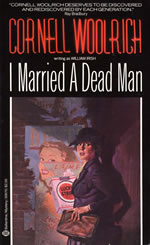I Married a Dead Man
 Cover Artist: Lawrence Schwinger
Cover Artist: Lawrence SchwingerBy: Woolrich, Cornell
Publisher: Ballantine Books (30670)
Place of Publication:New York, NY
Catalog #: Kelley Box 272: PS3515 .O6455 I2 1983
Contributor: D. Schmid
General
Era: 1940sAuthor as on Cover: William Irish
Publication:1983
Original Date: 1948
Setting: small town; pleasant, prosperous. Scenes in a train, in a hospital, and in a registry office
Plot Summary
I Married a Dead Man contains one of Woolrich's most convoluted plots. The book begins with a young woman, Helen, traveling to the West coast by train. About to give birth, she has been abandoned by the father of the child, and has little money and fewer prospects. On the train she meets and befriends Patrice Hazzard, a rich young woman who is also pregnant and about to meet the family of her husband, Hugh, for the first time. Just as Patrice lets Helen try on her wedding ring, the train crashes and Patrice and her husband are killed. Helen survives, and because she is wearing Patrice's wedding ring, Hugh Hazzard's family, never having seen a photo of the real Patrice, assume that Helen is Patrice, and so they welcome her into their family. Helen is initially racked by guilt at going along with the deception, but she persuades herself that she is only doing it for her child. At first, things go well, and when Hugh's brother, Bill, and Helen begin to fall in love, it seems as if Helen will have a blissfully happy and prosperous life. But then Helen starts to receive a series of anonymous letters from someone who clearly knows about her deception. The author of the letters turns out to be Helen's former boyfriend, Steve Georgesson, who has tracked her down and now blackmails Helen into marrying him, so that he may one day inherit the Hazzard fortune through Helen. Helen decides that she has no alternative but to kill Georgesson, but when she goes to his apartment, she finds him already shot dead. At this point, Helen is discovered by Bill, who immediately suspects Patrice of having killed Georgesson. But because of his presence on the scene, Helen in turn suspects Bill of having committed the murder. Even though they both escape being charged with the crime, their eventual fate is in some ways worse than being punished for Georgesson's death. Helen and Bill must love each other to distraction, but at the same time be eaten away by their suspicion of each other, to the extent that they can never enjoy their love or their freedom.Major Characters
Helen Georgesson adult female, became pregnant and was subsequently abandoned by her boyfriend, Steve. At the beginning of the story, she is travelling out to the West coast by train with very little money, trying to make a new start.Bill Hazzard adult male, brother of Hugh Hazzard, son of wealthy, upper-class parents. Almost against his will, Bill falls in love with the woman he thinks is his brother's widow, Patrice. When he finds out Helen's true identity, he still loves her, but that love is poisoned by the bizarre circumstances he and Helen find themselves in at the end of the novel.
Steve Georgesson adult male, boyfriend and later husband of Helen, petty thief and hustler. After abandoning Helen when she became pregnant, he later re-establishes contact with her when he learns of her new life with the Hazzards. He blackmails Helen into marrying him and is killed under mysterious circumstances
Patrice Hazzard adult female, young, wealthy, pregnant wife of Hugh Hazzard, killed in a train crash
Hugh Hazzard adult male, wealthy, husband of Patrice Hazzard, killed in train crash